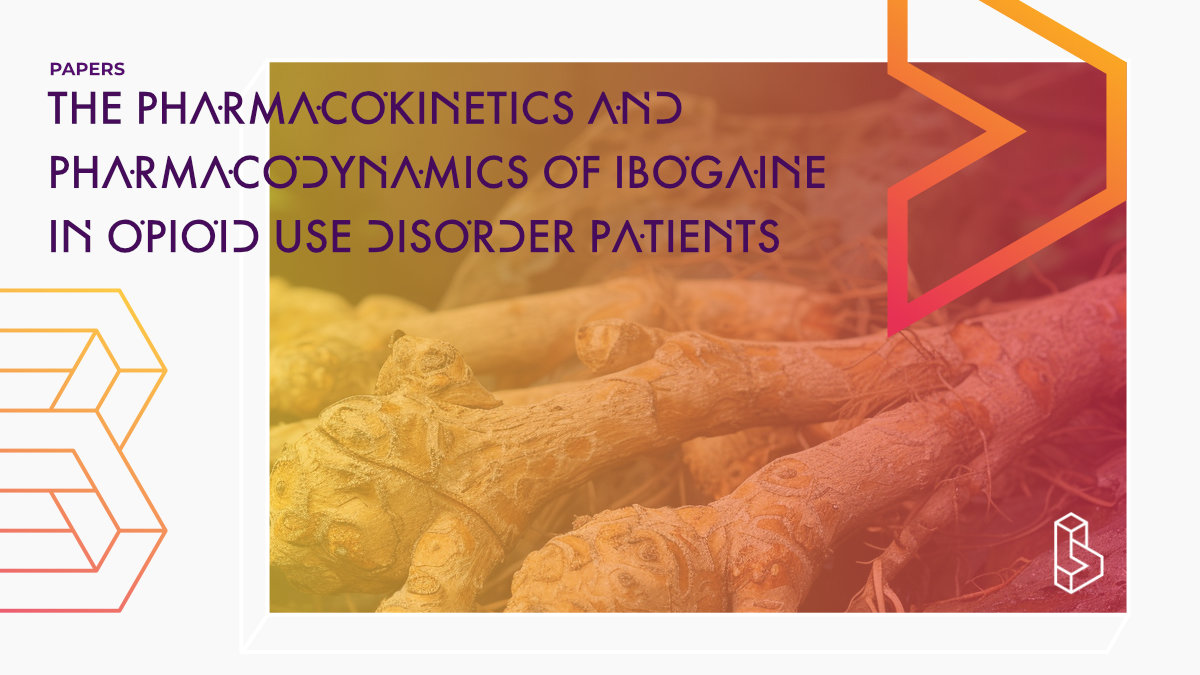This pharmacokinetic study (n=14) on ibogaine (700mg/70kg) for opioid use disorder (OUD) finds significant variability in ibogaine clearance, strongly correlated with CYP2D6 genotype. Ibogaine plasma concentrations correlate with QTc prolongation and cerebellar effects, while neither ibogaine nor noribogaine correlate with the severity of opioid withdrawal symptoms.
Abstract of The pharmacokinetics and pharmacodynamics of ibogaine in opioid use disorder patients
“Objective: Ibogaine is a hallucinogenic drug that may be used to treat opioid use disorder (OUD). The relationships between pharmacokinetics (PKs) of ibogaine and its metabolites and their clinical effects on side effects and opioid withdrawal severity are unknown. We aimed to study these relationships in patients with OUD undergoing detoxification supported by ibogaine.
Methods: The study was performed in 14 subjects with OUD. They received a single dose of 10mg/kg ibogaine hydrochloride. Plasma PKs of ibogaine, noribogaine, and noribogaine glucuronide were obtained during 24 h. Cytochrome P450 isoenzyme 2D6 (CYP2D6) genotyping was performed. The PKs were analyzed by means of nonlinear mixed effects modeling and related with corrected QT interval (QTc) prolongation, cerebellar ataxia, and opioid withdrawal severity.
Results: The PK of ibogaine were highly variable and significantly correlated to CYP2D6 genotype (p < 0.001). The basic clearance of ibogaine (at a CYP2D6 activity score (AS) of 0) was 0.82 L/h. This increased with 30.7 L/h for every point of AS. The relation between ibogaine plasma concentrations and QTc was best described by a sigmoid Emax model. Spearman correlations were significant (p < 0.03) for ibogaine but not noribogaine with QTc (p = 0.109) and cerebellar effects (p = 0.668); neither correlated with the severity of opioid withdrawal symptoms.
Conclusions: The clearance of ibogaine is strongly related to CYPD2D6 genotype. Ibogaine cardiac side effects (QTc time) and cerebellar effects are most likely more driven by ibogaine rather than noribogaine. Future studies should aim at exploring lower doses and/or applying individualized dosing based on CYP2D6 genotype.”
Authors: Thomas Knuijver, Rob Ter Heine, Arnt F. A. Schellekens, Paniz Heydari, Luc Lucas, Sjoerd Westra, Maarten Belgers, Toon Van Oosteren, Robbert Jan Verkes & Cornelis Kramers
Summary of The pharmacokinetics and pharmacodynamics of ibogaine in opioid use disorder patients
Introduction
Ibogaine is an active alkaloid compound found in the rootbark of the plant Tabernanthe iboga. It is used in treatment of various types of addiction, including opioid use disorder, in various settings from private clinics to home treatment.
Ibogaine may prolong the corrected QT interval (QTc) interval, which is a risk factor for torsades des pointes, a life-threatening dysrhythmia. It has also been shown to cause cerebellar ataxia, and it is not known whether these effects are due to ibogaine itself or its metabolites.
Find this paper
The pharmacokinetics and pharmacodynamics of ibogaine in opioid use disorder patients
https://doi.org/10.1177/02698811241237873
Open Access | Google Scholar | Backup | 🕊
Cite this paper (APA)
Knuijver, T., Ter Heine, R., Schellekens, A. F., Heydari, P., Lucas, L., Westra, S., ... & Kramers, C. (2024). The pharmacokinetics and pharmacodynamics of ibogaine in opioid use disorder patients. Journal of Psychopharmacology, 02698811241237873.
Study details
Compounds studied
Ibogaine
Topics studied
Opioid Use Disorder
Addiction
Study characteristics
Original
Open-Label
Participants
14
Humans
Institutes
Institutes associated with this publication
Radboud UniversityThis company page is linked to research but doesn't have a full profile yet.
Compound Details
The psychedelics given at which dose and how many times
Ibogaine 700 mg | 1xLinked Clinical Trial
The Efficacy of Ibogaine in the Treatment of Addiction; an open label, single fixed dose pilot-study of the efficacy of ibogaine in opioid-dependent subjectsThis open-label, single fixed dose pilot-study trial (n=12) aimed to investigate the efficacy of ibogaine in treating opioid dependence.

